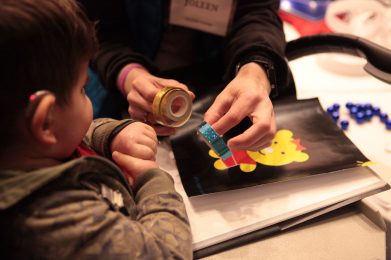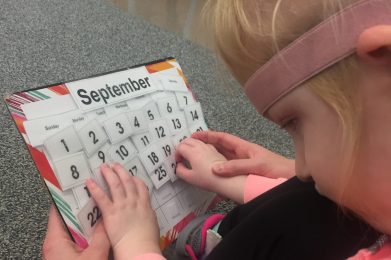Strategies
"Do With, Not For"



Intervention Strategies
When you use the hand-under-hand technique, your hands perform the activity while your child’s hands rest on top of yours—in this way, your child can feel what your hands are doing. If the activity is new to your child, and they are hesitant to try it, they may feel more secure touching your hands rather than the unknown object or activity. Also, because their palms are on your hands, they will be able to focus their energy on feeling the movements of your hands. They may also feel more comfortable and in control because they can freely remove their hands if they want to.
It is important to verbally describe what you are doing with your hands while performing the activity.
Suggestions for Hand Under Hand Intervention:
1.Try It Yourself
Before you show your child how to do something using the hand-under-hand method, try it yourself with your eyes closed. Pay attention to the steps you are taking to do the activity. Try to pick out things to point out to your child, such as the fact that buttonholes are near the edge of a blouse or shirt.
2. Give Multiple Demonstrations
Most children need multiple demonstrations of a new task to learn it. Because your child may not be able to see another person doing a task clearly or at all, the only demonstration they may receive is the one they feel through the use of hand-under-hand. Be patient and give them many opportunities to practice a new skill.
3. Respect their Message
Some children are resistant to trying new activities. they will pull their hands away and won’t want to touch. Try to respect the message your child is giving you if they do this. However, if they are not encouraged to try new things, they may not expand their understanding and interest in the world around them.
Talking the Language of the Hands to the Hands – Barbara Miles
Reflections on Deafblindness: Hand & Touch – Barbara Miles – Perkins School for the Blind
Hand Under Hand – Idaho Children and Youth with Deaf-Blindness
Hand Under Hand Video – Washington State Disabilities
Some children take longer to process the information they are receiving. It is important that they are given enough time to respond. Respect the child’s pace. We must wait, and wait and sometimes wait even longer. If we don’t allow this time, the child may give up trying to communicate. Follow the child’s lead.
Waiting time – shows respect, builds trust, lowers frustration/confusion, gives meaning to the activity, provides learning opportunities and provides for choice and informed decision making.
Providing the child with this opportunity to problem solve, communicate and to take control to direct the activity, makes them better communicators.
California Deafblind Services – Intervenor’s “Do With, Not For” – Gloria Rodriguez
Best Practices – Provincial Outreach Program for Students with Deafblindness Why It’s Worth The Wait Time – Provincial Outreach Program for Students with Deafblindness
There are FOUR main components that are needed for successful Intervention:
- Anticipation – How will I let the child know what is going to happen?
- Motivation – What is in this activity for the child?
- Communication – How will I communicate with the child in this activity and what do I expect from the child in terms of expressive communication?
- Confirmation – How will I let the child know when he is finished the activity and whether or not he/she has been successful?
Conversations: A Personal Reflection on Deafblindness – Barbara Miles – Perkins School for the Blind
Responsive Environment – Provincial Outreach Program for Students
Five Steps of Interaction – Paul Hart
Meaning Making – Texas Deafblind Project